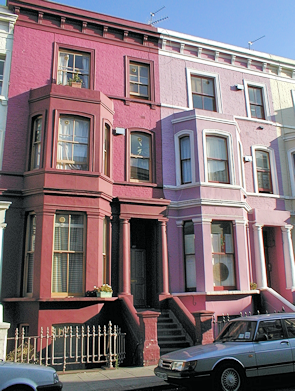Westbourne Park
Westbourne Park, Westminster/Kensington & Chelsea
A fashionable residential locality occupying a crescent of land made by the elevated section of the Westway, north-east of Notting Hill

The Westbourne is minor river that rises in Hampstead and flows 12 miles southwards into the Thames at Chelsea, nowadays mostly underground.
A mansion called Westbourne Place stood north of this locality in the 1640s, with grounds stretching in this direction. The property was later renamed Westbourne Park.
After the Great Western Railway came through the district in the late 1830s, a station was opened here, originally called Green Bridge.
In the mid-1850s the mansion was demolished and its grounds were covered by the generously proportioned semi-detached villas of Westbourne Park Road and Westbourne Park Villas, where the writer Thomas Hardy lived in the 1860s. For a while the new settlement was known as ‘Westbournia’.
In response to the influx of Roman Catholics to neighbouring North Kensington, the Poor Clare order established a monastery on Westbourne Park Road, with separate chapels for nuns and visitors.
Westbourne Park was served by Hammersmith & City Railway from 1866 and the station brought some commerce to the area but vibrations caused the collapse of four tradesmen’s houses in Westbourne Park Passage (now lost) in 1869. The station was rebuilt on its present site in 1871. Later in the century Westbourne Park Road was extended westwards by the simple device of renaming Cornwall Road.
Like much of the surrounding area, Westbourne Park had declined by the middle of the 20th century and many houses had been subdivided. The notorious slum landlord Peter Rachman bought his first property on St Stephen’s Gardens in the early 1950s, targeting newly arrived West Indian immigrants, whose difficulties in finding accommodation made them easier to exploit. Westminster council later acquired groups of run-down homes, rehabilitating some and replacing others with flats.
Westbourne Park was popular with hippies in the 1960s and has since attracted more respectable (and wealthy) figures from the worlds of fashion and music, with chic eateries and organic grocers that draw celebrity customers. The area’s population declined in the late 20th century as houses formerly occupied by several families were reunited into single households.
The blue door that featured prominently in the film Notting Hill belonged to a converted chapel in Westbourne Park Road, once owned by the film’s scriptwriter and co-producer Richard Curtis. The door was sold for £5,750 to a Portobello Road antiques dealer in 1999.
